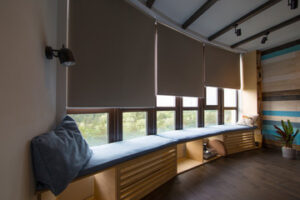Blinds are a practical way to manage incoming light, but can also add style to your home. They’re an affordable window treatment that offers a wide range of benefits.

Blinds come in a variety of styles, materials and colors. Some require more maintenance than others, so consider your lifestyle before choosing a type of blind. Visit https://www.customblindsandshadesky.com/ to learn more.
Window blinds, along with curtains and shades, are an important part of a home’s décor. But their impact extends far beyond the aesthetic. They act as vigilant moderators between the outside world and our homes, offering control over glare, light, and temperature. Blinds serve as a powerful tool for transforming interior spaces into beautiful and welcoming areas where families, friends, and memories are made.
There are several different types of window blinds to choose from, and each one offers a unique set of benefits for homeowners. The most common blinds are made of slats or louvers that can be lowered and stacked lengthwise like drapery, allowing you to control the amount of light that enters a room. These slats can be tilted in multiple positions to allow you to block out the light or filter it to suit your needs.
Typically made of wood, faux-wood, or woven fabric, these window treatments are available in a wide range of styles and finishes. They can be fixed inside the recess of the window frame, or mounted on a bracket that is secured to the wall. This mounting option allows the blinds to sit further back from the window sill and decorating molding, which creates a cleaner look. However, it can also make the blinds harder to reach.
Other popular window blinds are panel blinds, or panel track blinds, which operate on a track that allows the panels of fabric or material to move left and right to open and close. These are ideal for large windows and doors, and they can be mechanized to operate automatically. Other window blinds are made of a single layer of fabric that can be rolled up to reduce glare and provide privacy, or blackout liners that can be added for maximum filtration.
Blinds are also available in vertical slats that can be opened and closed for privacy, as well as horizontal louvers and shutter-style blinds. They can be fixed inside the window frame or on the wall above it, and they can be mounted in a variety of ways to accommodate oddly-shaped windows such as arched ones, angled tops, trapezoids, or octagons.
Increasing the Insulation
The material, style and size of window blinds can have a major impact on the insulation in your home. Insulating window blinds can make your home a lot cozier in summer and warmer in winter, while also saving you money on your energy bills. Blinds can be used alone or layered with curtains to enhance their insulating capability.
Insulated window blinds are a great way to increase the R-value in your windows without the expense of replacing the windows themselves. They can help to reduce heat loss by blocking the flow of air through the windows and reducing drafts. They can also reduce the amount of direct sunlight that enters the room, keeping the room cooler in the summer and reducing the need to use artificial lighting.
One of the best types of insulated window blinds are double honeycomb cellular shades, which have multiple layers of hexagonal cells that trap air. This design increases the insulating value of the blind by slowing down the thermal transfer through the window. This type of insulated blind can have a high R-value, such as R-5 or higher, depending on the design and fabric used.
Another good option for insulating window blinds is thermal lined roman shades, which cover the entire window space leaving little space for hot or cold air to escape. They can be made with a variety of fabrics to suit your aesthetic and insulating needs, and you can choose from many options for the type of mechanism by which they are raised and lowered, including motorization.
In addition to insulated window blinds, other ways of improving insulation in your home include using energy efficient windows and caulking around the edges of the window frames and sills. Adding thick curtains or draperies to your blinds can also improve their insulating capabilities by preventing air leakage around the window.
The right style of blinds can significantly increase the insulating capacity in your home, making it more comfortable all year round. Insulated window blinds are available in a variety of styles, materials and colors to complement any decor. Choosing the correct blinds for your home can be tricky, but with some research and careful consideration, you should be able to find a solution that meets all of your requirements.
Enhancing the Aesthetics
Window blinds have long transcended their functional role to become expressive decor elements that infuse spaces with personality. They offer a diverse array of aesthetic options, from sleek roller blinds in contemporary fabrics to elegant Roman shades offering soft, folded aesthetics. Depending on their style and build, blinds can seamlessly integrate into or boldly stand out in a room’s design, serving as a backdrop or a focal point.
Moreover, the innovative insulative properties of many blinds can enhance a space’s interior design while reducing energy costs. For example, cellular shades trap air to form an insulating barrier between the window and the surrounding room, which can help manage indoor temperatures while cutting down on utility bills. Blinds can also protect furniture, floors, and artwork from harmful UV rays, which promotes their longevity and protects them from discoloration and damage.
Blinds come in a range of styles, materials, and colors, making them versatile design elements for any space. For example, if you are looking to make a statement with your decor, choose a brightly patterned roller shade to support the color theme of your room. If you prefer a more minimalist look, opt for a neutral-colored or metallic blind for a clean aesthetic. Blinds can also be paired with curtains or drapes to add more depth and texture to a space.
Additionally, blinds can be custom-fitted to any size and shape of window, including skylights and unusually sized windows. This ensures a smooth, tailored look that complements your home’s interior design. Additionally, technological advancements have introduced motorised blinds that can be controlled remotely and integrated into smart home systems. This added convenience allows you to effortlessly change the ambiance and light of a room at the touch of a button.
Enhancing the Privacy
Window blinds help you control light and privacy in your home. They come in a wide range of styles and fabrics, so you can find one that blends perfectly with your decor while providing the desired level of privacy. Additionally, many window blinds come with a lockable feature that helps protect your home’s interiors from unauthorized entry.
The slat system used by window blinds allows you to customize the amount of natural light you want to let in. You can also angle the slats to block prying eyes from peering into your home. This feature can be particularly effective in ground-floor rooms that face a busy street.
Unlike curtains, which can block the entire window, blinds are a good option for rooms that receive excessive sunlight. In such a room, composite and faux wood blinds can offer a good amount of light control without darkening the interior. These blinds can help you reduce screen glare and save energy by managing the sun’s heat.
Another type of window blind that offers a balance between privacy and natural light is the Roman shade. These shades feature horizontal fabric pleats that fold neatly when they are open. They also have a liner behind the fabric that faces out of the window for a uniform look. They are a good choice for casual rooms such as living and family spaces.
You can also opt for vertical blinds if you want to enjoy the benefits of natural light without sacrificing privacy. These blinds can be angled to block the view from outside while letting in enough sunlight to make your home feel bright and airy. They are a great option for large windows and sliding doors.
Smart blinds are an innovative solution that combines the convenience of modern technology with traditional window treatment options. These blinds are controlled by a mobile app or voice command and can be adjusted automatically based on the time of day and varying sunlight intensity. They are a perfect choice for families with children, as they can help to avoid the risk of accidental strangulation from cords.
